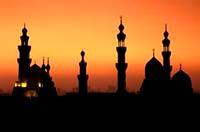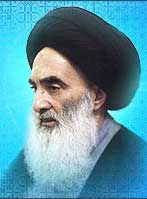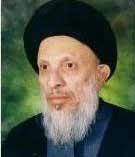|
|
Iraq’s
Shi’a – Prospects for a New Iraq
April 2003 Commentary by Rick Francona
``If you're suggesting, how would we feel about an Iranian type government with a few clerics running everything in the country, the answer is: That isn't going to happen.'' -- Donald Rumsfeld, U.S. Secretary of Defense
Not surprisingly, there are signs of an Iranian hand in the mounting opposition to continued American military presence in the country. What is surprising, however, is the degree of organization and sophistication of Iranian organized efforts calling for the establishment of an Islamic government in Iraq. Iran has been accused of infiltrating operatives into southern Iraq to shape Shi’a opinion and support clerics that favor the same goals as Iran. These operatives come from three sources, two Iranian and one Iraqi. The two Iranian organizations are the Islamic Revolutionary Guard Corps (IRGC), or the Pasdaran, and the Ministry of Intelligence and Security (MOIS). Both are capable organizations with considerable experience in fomenting Islamic uprisings. They were used in southern Iraq in 1991 and were responsible for the Shi’a uprising that was so brutally put down by the regime of Saddam Husayn. The Iraqi organization is the Supreme Council for the Islamic Revolution in Iraq, or SCIRI, led by cleric Muhammad Baqir Al-Hakim. SCIRI has a military arm of about five brigades called the Badr Corps. SCIRI boycotted the An-Nasiriyah meeting of Iraqi factions to protest what it perceives as American moves to marginalize Islamic groups. Iraq’s Shi’a are not a monolithic group. There is a definite split between Shi’a that favor the establishment of an Islamic republic, similar to that of neighboring Iran, and those who favor a more moderate approach, creation of a Muslim state that is inclusive of the Sunni and Kurdish minorities. Of course, Iranian support is geared to those favoring an Islamic republic. Iraq’s Shi’a Leaders · Grand Ayatollah Al-Haj Al-Sayid ‘Ali Al-Husayni Al-Sistani
Ayatollah Al-Sistani, 72, is a grand ayatollah, the highest theological degree in the Shi’a sect, has made three pilgrimages to Mecca (hence the title “Haj”), and is a descendant of the Prophet, as indicated by the title “Al-Sayid” and the wearing of the black turban. Ayatollah Al-Sistani is the leading cleric of the An-Najaf school (“hawza”) of the late Grand Ayatollah Al-Sayid ‘Abd Al-Qasim Al-Khu’i and successor to late Grand Ayatollah Muhammad Sadiq Al-Sadr, who was killed by the regime in 1999. Although born in Mashhad, Iran, he has lived, studied and taught in An-Najaf for almost half a century. Educated in Qom, Iran as well as An-Najaf, Ayatollah Al-Sistani is highly regarded for his work on the role of religion in Muslim states. He does not favor the establishment of an Islamic republic in Iraq. · Ayatollah Muhammad Baqir Al-Hakim
Ayatollah Al-Hakim, 64, is the leader of the largest Iraqi opposition exile group, Iran based SCIRI. Although SCIRI maintains ties to the U.S.-backed Iraqi National Congress, SCIRI is opposed to both American military presence in Iraq and to the establishment of an interim U.S. authority in the country. · Muqtada Al-Sadr Muqtada Al-Sadr is the son of Ayatollah Al-Sistani's predecessor, Ayatollah Muhammad Sadiq Al-Sadr, who was assassinated in 1999 in An-Najaf, along with two of Muqtada’s brothers. Although Al-Sadr is too young – he is in his 20’s – and does not have the Islamic credentials to take on a leadership role, his family name lends credibility. In fact, Saddam city, the huge lower-class Shi’a section of northeast Baghdad, has just been renamed Sadr City in honor of Muqtada’s father. Muqtada’s followers favor an expanded role for the clergy in the new Iraqi government, whatever that happens to be, and are opposed to the presence of American troops. A fatwa (religious edict) issued by an senior Iraqi cleric based in Qom, Iran, labeled Muqtada Al-Sadr as his representative for all religious matters, and appointed Shaykh Muhammad Al-Fartusi as administrator of eastern Baghdad. Al-Fartusi was detained by American forces for openly carrying a weapon in defiance of American orders, causing street demonstrations in major cities in Shi'a areas of Iraq. A wrench in the works... On April 10, Hawjat Al-Islam (a Shi’a clerical rank below ayatollah) Al-Sayid ‘Abd Al-Majid Al-Khu’i, son of revered cleric Grand Ayatollah Al-Sayid ‘Abd Al-Qasim Al-Khu’i was killed while attending a meeting in the mosque of ‘Ali in An-Najaf. Al-Khu’i was killed during an altercation with rival Shi’a clerics who favored the creation of an Islamic state. Some witnesses claim that the killers were followers of Muqtada Al-Sadr. A few days after Al-Khu’i’s
murder, a crowd surrounded Ayatollah Al-Sistani's home in An-Najaf.
Al-Sistani supporters have since dispersed the crowd and provided protection
to the cleric. Al-Sistani has since made statements that he does
not favor an American occupation, but has urged Iraq’s Shi’a population
not to interfere with the American attempts to restore order. He
stated that he would support whatever form of government the people of
Iraq want.
|


